As an Amazon Associate I earn from qualifying purchases.
This venison steak recipe tastes as good as it looks.
What follows is a guide to cooking venison steaks in general, as well as the specific recipe for venison with caramelized onions and mushrooms you see in the picture.

Let’s start with what I am talking about: venison steak, not backstrap. Yes, I know they are the same cut of meat, i.e., the loin. Ribeye in beef. But here I am referring to what you see in the picture, thick slabs of loin you use a knife and fork for. You know, like a regular steak, not thin slices.
If you are dealing with most American deer, I suggest keeping the backstrap in foot-long lengths and cooking it that way, then slicing. For a more traditional beef-like venison steak, you really want to cut them only from larger animals, like elk, moose, really big deer, nilgai, that sort of thing.
And if you do, cut your steaks about an inch thick or more. After all, who wants a skinny steak?
Prepping Venison Steaks
First and foremost, you want your meat to approach room temperature before you start. This prevents the “black and blue” effect, where the outside is nicely browned, but the interior is still cold. Unless of course you like that.
Cooking a venison steak can be tricky because it has no internal fat, and fat is your insurance policy against dry meat. Anyone can make a wagyu steak taste good, but it takes skill to cook a perfect venison steak. So heed the Prime Directive: You can always cook meat more, but you can never uncook it. So err on the side of undercooking.
Starting with a room temperature steak helps the meat cook evenly. Salt it when it comes out of the fridge and let it rest up to 1 hour, and at least 20 minutes. Cut steaks need less time than big lengths of backstrap.
Playing with Flavors
I am partial to the flavors of salt, fire and meat, maybe with a squeeze of citrus at the end. But many people will want to sex up their venison steak with other flavors.
Start by reading my article on venison marinades if that’s the route you want to go, but with most steaks you will simply want to either choose any of my many sauces for wild game, or dust the meat with spices and herbs after you’ve cooked it.
You read correctly. After. Many herbs and spices will burn and turn bitter if you put them on initially. Paprika is notorious for this. Far better to have a spice mix ready, then dust the venison steak with it immediately as it comes off the heat. As the meat rests, the spices will combine with the juices to flavor the steak. Porcini powder is especially good with venison.
Rest Thine Venison Steak
This is vital. Any steak needs to rest after it comes off the heat, unless you are serving it dead rare, like 120°F internal. Anything higher and you will want to rest venison steaks 5 to 10 minutes, lengths of backstrap 10 to 15 minutes.
Resting allows the juices in the meat to settle, so you don’t have a flood of deliciousness inundate your cutting board when you slice your steaks.

Reverse Sear
An excellent method of cooking venison steak is to reverse sear it. This means you are slowly cooking the meat at low temperatures until it gets reasonably close to done, then searing it to get a nice crust.
You need a meat thermometer to do it right, the probe kind that sticks into the meat. I mostly do this with lengths of backstrap, not venison steaks, but it will work if the steak is big and thick.
Simply salt your meat and let it come to room temperature as normal, then cook on a rack in the oven or a smoker (even better) at about 200°F until the center of the meat hits about 120°F. Then you sear the venison steak hard, hot and fast to get a nice crust. Add your flavorings, let it rest, and serve.
The Recipe
So when I designed this recipe, rather than riff off an existing venison steak recipe, I decided to do the ole’ refrigerator roulette. I found some caramelized onions I’d made a day or so before, and I had some fantastic hen-of-the-woods mushrooms. If you’ve never had hen-of-the-woods, they’re also known as maitake — or Grifola frondosa for the Latin-inclined. They are a brownish-gray tree mushroom that lives in many places, California not among them.
To my mind, they are the best-eating mushroom that doesn’t live in Cali: Firm, aromatic, they sear well and have a mild, mushroomy flavor that’s addicting. And like almost every shroom, they go great with caramelized onions. But any mushroom will work.
Venison steak. Mushrooms. Caramelized onions. Classic and bangin’. But the dish needed a “green thing,” as my mum likes to call it. Parsley’s a given, and in spring, miner’s lettuce or dandelion greens are a good call, as is arugula or chicory or endive. Bitter greens really balance the richness of everything else on the plate. So damn good.
If you make this recipe verbatim you will love it. But the larger point is to play your own game of refrigerator roulette. Balance flavors: something sweet (caramelized onions), something savory (mushrooms and steak), something salty, bitter or sour, spicy — a good dish keeps all of these balls in the air at the same time. A nice wild rice pilaf is another good option.
You can leave out few, as this dish does, or try to get them all in there, which is a little harder but the result can be amazing. Color is important, as is temperature.
Add stuff all you want, but always remember that famous quote from legendary fashionista Coco Chanel: “Before you go out, always take something off.” That applies to food, too. Simple is good. Restraint is power.
Enjoy!
(Rather hit the grill? Try my recipe for grilled venison steak. Or try the classic, Venison Steak Diane. You won’t be sorry.)
Venison Steak with Caramelized Onions and Mushrooms
Ingredients
- 1/4 cup unsalted butter, divided
- 3 onions, peeled and sliced from root to tip
- Salt
- 1 teaspoon dried thyme
- 2 teaspoons honey (optional)
- 1 pound venison backstrap
- Porcini powder (optional)
- 1/2 pound fresh mushrooms, ideally hen of the woods a/k/a maitake, sliced
- 3 tablespoons fresh chopped parsley
- Dandelion leaves, arugula, watercress, or chicory (optional, for garnish)
Instructions
- Start by caramelizing the onions. Heat 2 tablespoons of the butter in a large sauté pan over medium-high heat. When it's hot, add the onions and toss to coat. Cover the onions, turn the heat down and cook slowly, stirring once in a while. You are looking for them to slowly soften and brown, not scorch on the edges. After 10 minutes or so, they'll start to get soft. Sprinkle salt over them and let them cook some more. When they are just starting to brown, add the thyme and honey. Cook until they are a nice brown. Remove and set aside. The onions can be made in advance.
- While the onions are cooking, take the venison out of the fridge and salt it well. Let it come to room temperature the whole time you are cooking the onions; this is especially important if you are using elk or moose backstrap, which is thick.
- When the onions are done, wipe out the pan and add the remaining butter. Pat the venison dry with a paper towel and sear it over medium-high heat, turning it to make sure all sides are well browned. Use the finger test for doneness (See notes, below) to determine when to take it out of the pan. Let the meat rest on a cutting board. If you have some, roll the venison in the porcini powder as it rests.
- While the venison is resting, put the mushrooms in the pan and turn the heat to high. Sear the mushrooms until they release their water; this might not happen with hen of the woods. When the water has almost boiled away or when the mushrooms begin to brown, add some more butter and sauté hard until the mushrooms are nicely browned. Salt them as they cook.
- Once the mushrooms are ready, add back the caramelized onions and the parsley and toss to combine. Heat through and put some on everyone's plate. Add the dandelion leaves if you are using them. Slice the venison into medallions and serve.
Notes
Keys to Success
- If you want to try the reverse sear method, insert a probe thermometer into the thickest part of the meat and smoke or cook in the oven at 200°F until the interior of the meat hits 120°F. Then sear hard in the directions above, but at high heat only until you get some nice browning. Then rest and proceed.
- As I mention, the caramelized onions can be made up to a couple days in advance and stored in the fridge.
- Another route for your venison steak would be my classic French mushroom sauce.
Nutrition
Nutrition information is automatically calculated, so should only be used as an approximation.
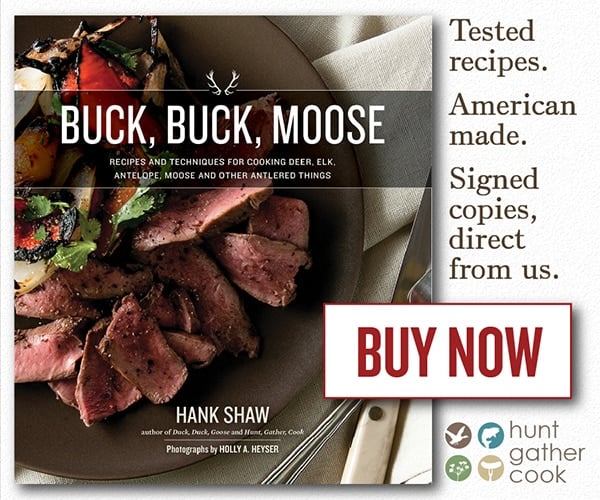

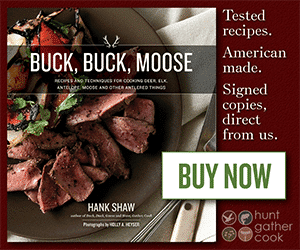
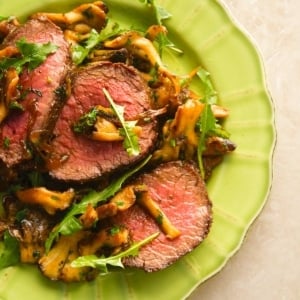

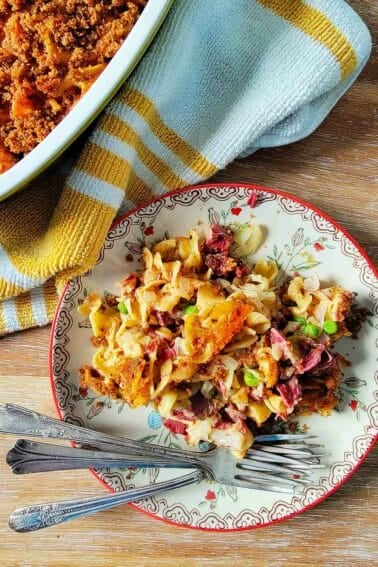
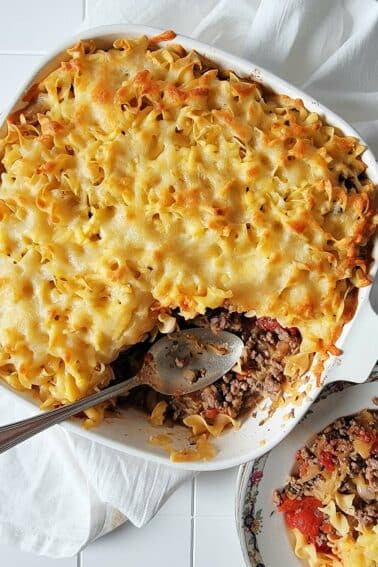
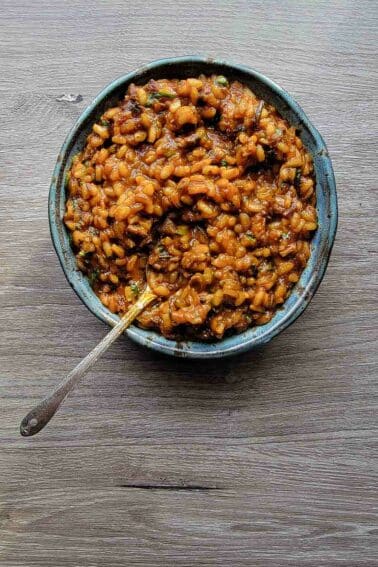
I learned more about cooking meat on this one page than all the cookbooks on my shelves!
I have just one question/comment. You refer to “steak” as only those cuts from the loin. I butcher my own deer (not a small accomplishment for a 71 yr old ex-vegan of 25 years!) and work very hard to keep that deer hanging long enough to tenderize other hindquarter cuts for steaks and stir-frys. Would you not consider top round as suitable for steaks? With a bit of trepidation, I tried using this recipe with a top round steak I had thawed. I used Shitaake mushrooms and seared the steak in the cast iron pan for 2 minutes per side. I used the “finger test”, which I had just learned from the link you provided. Success.
I want to thank you for more than a recipe; you have opened up a whole new adventure in turning what has heretofore been “necessary nutrition” into true enjoyment. And it wasn’t very hard to do!
I will be following you from now on to keep learning. Thank you!
Tried and true favorite for elk or deer backstrap!
The thyme really makes it sing.
I made it for dinner and we had with a nice Pinot Noir. I also added a splash into the butter that I used to cook the steaks. We will repeat this recipe with any blackstrap I get. Next time I might try it with a side of egg noodles instead of potatoes.
I used fresh poke weed instead of dandelion, DELISH
Just made this recipes, easy and delicious, only difference i deglazed the mushrooms with Merlot wine,
How long do you think the blackstrap needs to be in the 235 degree oven?
Steve: Are you talking Celsius? If so, maybe 10 minutes?
Hank, what a simple and excellent recipe! I made this tonight with some backstrap medallions from a deer I shot a couple weeks ago, but used shallots instead of onions. My wife was not a red meat person and grew up eating below-average quality cooking so she’s really picky, but dishes like this continue to convert her, she wants more! Thanks for your hard work on this blog, we love it!
Wow what a great recipe although I’ve generally seared with the porcini dust already on the backstrap and finish in oven but I want to try it like Erik suggested..I did a roast beef that way about a month ago and I’m sold on that strategy. It was awesome. I am the camp cook here in upstate NY plus an avid mushroom gatherer. The Grifola is one of the only reasons I don’t live in perpetual jealousy of the folks on the mid to upper left coast. That Instagram shot of that giant porcini was borderline mean! They get so buggy here and I love them . Again, this is just a super recipe – I will lay something like this on the boys next weekend as we have a bunch hanging all week. Thanks Hank – this is my go to website. I may try rolling the backstrap in the porcini after the sear as you have me intrigued.
Hi Hank-
Your website is awesome I love to hunt and cook game here in Minnesota, your old stomping grounds. One question/comment: When cooking venison backstraps (deer or elk), I always sear the exterior as you describe, but once I have a crusty, dark bark on the backstrap I put it in an oven at 235 degrees (with a probe thermometer). The internal temp of the backstrap is usually around 75 degrees initially. After it slowly reaches 129 degrees, I pull it from the oven and let it rest under foil. The meat temp usually peaks at 135 degrees. When sliced, its looks like roast beef, crusty exterior but an even pink/red throughout most of the meat, without much well done gray on the edges. And delicious! Someone once explained to me the low and slow finish in the oven makes for a more even, balanced rare/med rare interior, and gave some scientific reason. I probably lost interest during the dissertation and focused on my beer instead. Wish I hadn’t. Anyway, this method REALLY works for me. I’ve cooked this way in deer camp without the oven or thermometer, and just used the finger test, and its equally great without digital precision.
Your thoughts or comments?
Skol from Minnesota,
Erik
Erik: That method works great. I sometimes do it, but with my method there is no need to turn on the oven. It’s six of one, half-dozen of another IMHO.
This looks fantastic. We have some Elk steaks in our freezer and have been told that it’s a little tough and doesn’t have the best flavor. Any ideas for what to do with it if that’s the case?
Thanks,
Justin
Justin: If you think the meat will be tough, you will need to slice it thin when you serve it. So maybe cook the backstrap and then slice like roast beef and then add to the onions and mushrooms.
Just as I saw this recipe I had something similar planned for my dinner tonight. However I am a sandwich man and it will all be on top of a big roll! This will be the fiance’s first taste of Deer backstrap so hopefully I knock this one out of the park!
That looks delicious — and so beautifully presented, as well!
Thanks for all your posts.
I knew those were dandelions! How great to see someone using them in a “serious” recipe. It’s great reading how you’ve tried to make some of the recipes you’ve posted lately as locally flavored as possible; eating in course with the seasons. I’ve never thought of using dandelions as a garnish, they certainly can add some interest to a meal (especially if they come straight from the front yard), plus they’re extra healthy!
Thanks so much for sharing.